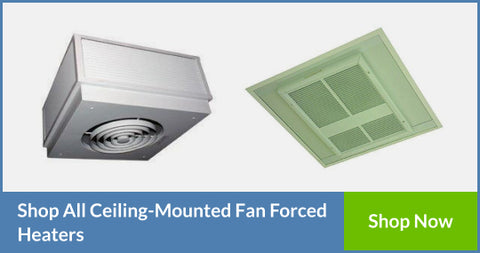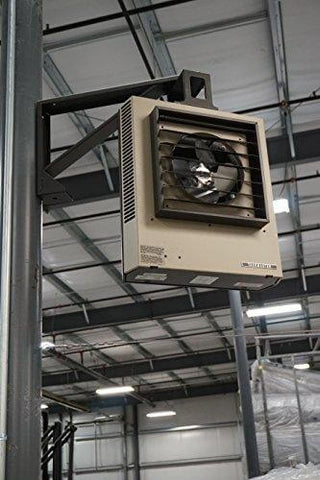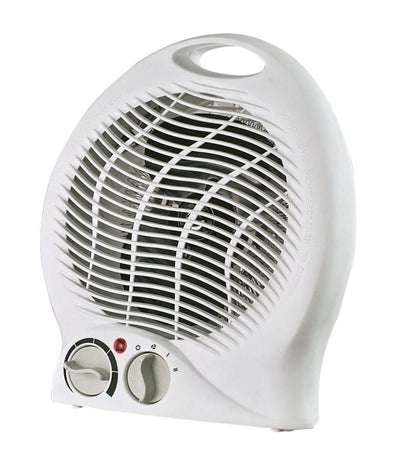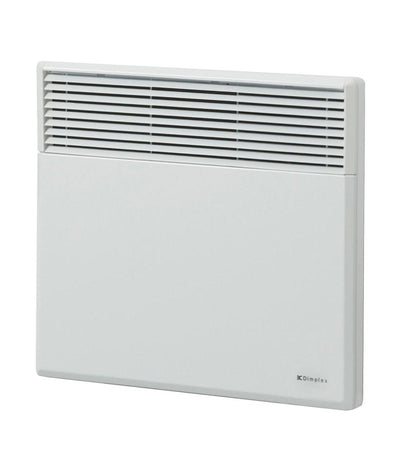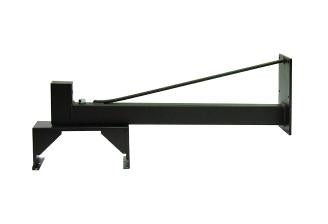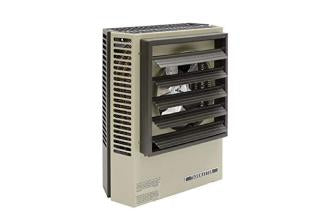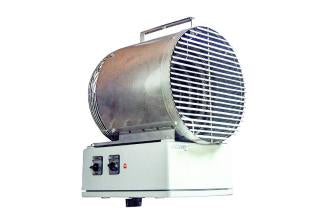Fan forced heaters are perhaps one of the more common heaters out there, and are also often quite flexible. They all have the same basic heat-spreading mechanism, though they can have different types of heating sources. Other kinds of heaters, such as infrared or convection heaters, can also have a fan forced mechanism. This is probably a testament to how effective this mode of heating is.
This article is an exploration of fan forced heaters and what they bring to the table. What kinds of fan forced heaters are there? How efficient are they? How do they work? Answer these questions and more below.
Fan Forced Heater Basics
Fan forced heaters aren’t complicated, and can be quite easy to understand and to learn how to use. Though there are a number of kinds of fan forced heaters, what they all have in common is the use of a fan to blow heated air into a space.
1. How They Work

There aren’t any complicated machinery or principles involved in making fan forced heaters work, since they’re generally straightforward. You have an internal fan, ensconced deep inside the body of the heater. Once the heater turns on, so does this fan. It then blows air over the heat source within the heater, pushing the heated air out into the room or space.
This fan and its ability to spread heated air is at the core of how fan forced heaters work. It is basically this particular mechanism that defines fan forced heaters and sets it apart from other types of heaters. For example, convection heaters work by relying on air convection currents. These currents circulate through the heater, thus catalyzing the spread of heated air. Unlike convection and fan forced heaters, which heat the air, infrared heaters heat up objects and people instead. Thus, a fan forced heater is one that actively heats and circulates air in order to facilitate space heating.
Additionally, there are some fan forced heaters that have summer fan switches, which can turn on the fan without turning on the heat source. Thus, the heater can still be able to blow cool air, which can come in handy during the summer.
2. Heat Sources
The fans within fan forced heaters are always powered by electricity. However, the heat sources used by these heaters can vary.
Some types of fan forced heaters use heat sources such as burning gas, kerosene, or even engine oil. Of course, depending on your situation and preferences, you might prefer not to resort to using burning substances for heating. These kinds of heaters can be safe as long as they are used properly, but kerosene in particular can release low amounts of carbon monoxide into the air.
Gas and kerosene fan forced heaters are suitable for outdoor use, though they can also be safe to use indoors as long as they were made specifically for that purpose.
Other fan forced heaters, meanwhile, use hot water tubing. This is suitable for buildings with a hydronic heating system. These heaters are good for use in apartments, kitchens, and bedrooms.
However, fan forced heaters more commonly use electric heating elements as heat sources. These heating elements are typically made of metal, such as nickel chromium. The heating element would start to heat up once the heater is turned on, producing the heat that the heater’s fan would blow into the intended space. Heaters with metal heating elements can be suitable for industrial applications.
Additionally, heaters like this can also come with a thermal limit. This is a mechanism that turns off the heating element once it senses that the heater is getting too hot. Consequently, this prevents overheating and damage to the heater.
3. Safety
Like most things, fan forced heaters are safe to use as long as they are used properly according to their specifications and the manufacturer’s recommendations. The thermal limit also helps ensure that the heaters can keep running without risk of overheating and damage. Still, these heaters are full of live electric parts, and most of them are not safe to use in areas that get a lot of moisture.
However, wash-down fan forced heaters, discussed below, can be safely doused in water.
Efficiency and Energy Use
How much energy do fan forced heaters use up? Are they more or less energy efficient than other types of heaters?
The very construction of fan forced heaters make them pretty energy efficient. Since the fans blow heat away from the heaters, there’s no issue with making them smaller while avoiding overheating at the same time. Additionally, the energy used by the heaters is converted to useful heat. Thus, the heaters waste little to none of the already small amount of energy they need.
All fan forced heaters use electricity, though those that use gas, kerosene, and oil only need electricity to run the fan.
These heaters also come in a variety of voltages, and you can choose the one that’s best suited and safest for your area. 120VAC, 208VAC, 240VAC, and 208/240VAC models are available. The purpose of the heaters also matter; you would need to make sure that you choose residential heaters for residential applications, and industrial heaters for industrial applications.
Types of Fan Forced Heaters
Fan forced heaters can vary by heat source, but even heaters with metal heating elements come in different types. Some are mounted on the wall, some on the ceiling, and others can be mounted on both. Some are installed under cabinets, while others are installed in floors or structures like sheds. Also, there are wash-down fan forced heaters that can withstand high levels of moisture without damage.
1. Ceiling-Mounted Fan Forced Heaters
Ceiling-mounted fan forced heaters offer a lot of benefits, not the least of which is their ability to allow you to save floor space. Since these heaters are mounted high up on the ceiling, they won’t have to take up space on the floor, leaving more space to accommodate more furniture, equipment, or storage. They are also ideal for smaller areas such as hallways or bathrooms, but also for larger areas.
There isn’t a single style of ceiling heaters. Some can have recessed mounting, and it can be set flush against the surface of the ceiling. Others, meanwhile, can be mounted on the surface itself.
Predictably, ceiling-mounted heaters tend to blow heated air down vertically. This might seem inefficient, since hot air does rise up after all. However, vertical heating works just as well as horizontal heating, especially when it comes to fan forced heaters, since the fan does drive the heated air down anyway. Ceiling-mounted fan forced heaters can thus be a good choice, depending on your requirements and preferences.
There is a variety of ceiling mounted heaters out there, coming in different styles, with different voltages, and with different heating elements. They can be used in residential buildings, malls, large retail stores, warehouses, garages, classrooms, libraries, and more.
2. Wall-Mounted Fan Forced Heaters
Wall-mounted heaters, just like ceiling-mounted heaters, can help free up floor space for furniture and other things. They’ll be able to fit easily into small spaces, such as bathrooms and small offices, and they’ll also be able to work well in large areas such as warehouses and large workshops. However, for heating larger areas, more than one wall heater might be necessary. Additionally, wall-mounted heaters can also be good for both surface and recessed mounting. This would rely on the construction of the heaters as well as the type of mounts that they can work with.
While wall heaters are generally safe, there are some precautions that need to be taken when these heaters are in use. For one thing, it’s important to remember to keep the area around the heater free from combustible and flammable objects, such as paper and even upholstered furniture. As a general rule of thumb, avoid placing anything combustible or flammable within three feet of the heater.
However, wall heaters do warm up quickly, unless there is a draft or a lack of insulation. Plus, they have built-in mechanisms that ensure that they won’t overheat. The room or area will also remain warm for hours after the heater has been turned off.
3. Wash-Down Fan Forced Heaters
Typically, fan forced heaters should be kept away from water and moisture. After all, they have live electric parts inside of them, which can be damaged by contact with water. However, wash-down fan forced heaters were especially built to withstand water. They are ideal for use on sites such as offshore drilling platforms, treatment plants, and more.
Certain environments and job sites tend to be dirty and dusty. Thus, equipment in these places can accumulate dirt and need to be cleaned and washed down. Wash-down heaters are ideal for these kinds of environments. They have a corrosion-resistant construction, and they are totally enclosed and watertight. Thus, the heating element and other electric parts are safe from water damage.
These heaters are thus perfectly safe to use in rough and busy industrial environments. Their controls are typically non-metallic in order to avoid corrosion. It’s important to make sure that these controls are certified by NEMA for utmost safety. Of course, wash-down heaters can also benefit sites that don’t typically get dirty or rough, but nonetheless have high humidity. If other types of heaters won’t be able to withstand the humidity in these particular areas, a wash-down fan forced heater is still a good thing to have.
4. Kickspace Fan Forced Heaters
Certain areas in a house or place of work can be difficult to heat. It can be the kitchen, bathroom, or other rooms or areas. While you can certainly resort to using portable space heaters to make these areas more cozy, this can cost you floor space that you can use for other furniture and equipment. Use your space efficiently by installing kickspace fan forced heaters, an effective way to keep yourself warm and comfortable wherever you may be in your home or facility.
Kickspace heaters, as the name might suggest, are typically installed under cabinets or cupboards. They are thus kept out of the way, though people will still be able to enjoy the warmth that the heaters produce. Additionally, kickspace heaters are a good alternative for baseboard heaters. Of course, it’s important to note that kickspace heaters shouldn’t be expected to be able to heat the entirety of a large area. They’re function more as space heaters, and were designed to efficiently heat a limited space.
There are different kinds of kickspace heaters, depending on their heat sources. Some are hydronic units, which means they rely on boiling water to produce heat. Others, meanwhile, have electric heating elements made of metal.
5. Drop-In Fan Forced Heaters
Much like kickspace heaters, drop-in fan forced heaters are made to heat up hard-to-reach spaces, as well as spaces that will be difficult for room heaters to heat up. In the harsher months of winter, drop-in heaters can work well if they’re installed under desks or tables.
This kind of heater can also work well in hallways, staircase landings, or other areas wherein space is limited. However, it’s best not to use this kind of heater in bathrooms or kitchens. Drop-in heaters are typically installed into floors, with their grilled openings facing up. Bathrooms and kitchens have a lot of moisture that will likely find itself into the inside of the heaters. This can corrode the live electric components inside and even cause the heaters to short circuit.
It’s also important not to install these heaters any place where objects like curtains or doors might obstruct airflow. Avoid placing combustible or flammable objects in the area near the heaters as well in order to avoid accidents.
Like other specialized heaters, drop-in fan forced heaters are made to supplement heating systems that are already in place, but don’t quite reach all areas in the building. They can ensure proper heating at all times, which can help promote productivity in the workplace and comfort in the home.
Pros and Cons of Using Fan Forced Heaters
As stated above, these fan forced heaters aren’t elaborate or complicated. They’re built to be relatively simple and straightforward. As such, they tend to be less expensive than other types of heaters. They can heat up much more quickly than other types of heaters, which means that they can use energy more efficiently.
Even though fan forced heaters heat up quickly, they are highly safe to use. They come with thermal limits that switch the heaters off when they go past a prescribed temperature threshold. In other words, when the heaters get too hot, they deactivate their heat sources in order to prevent overheating.
They can also be installed into various rooms and areas in a building without necessitating changes to the existing heating system. Additionally, this kind of heaters can be installed in rooms and areas that do not yet have a heating system, but are in need of one. They are also suitable for both small and large areas, though this will depend on the heaters’ specifications.
There are also fan forced heater units that come with a summer fan switch. In the summer, the heating function of these heaters won’t be needed. Even so, they won’t be completely useless. The summer fan switch can turn the heaters’ fans on without activating the heat sources. Thus, the units can blow unheated air.
Of course, there are still some disadvantages to consider. For example, fan forced heaters are known to have the tendency to produce some noise, due to their internal fans. Also, some units might turn off too soon or too frequently because of the thermal limit. However, this particular issue likely depends on the quality of the unit. It is therefore important to choose high-quality fan forced heaters that can work reliably well.
What Do Reviews Say?
Before you place an order for a fan forced heater, it’s imperative to first do research on which brands and models will serve your needs best. One of the best ways to do this is to read reviews left by people who have tried and tested the product you want.
So which fan forced heater brands seem to be the most trusted? It seems that it depends on the nature of use. Some brands specialize in manufacturing heaters for residential use, while other brands specialize more in commercial and industrial applications.
It seems that for fan forced heaters for residential environments, brands like Honeywell, BOVADO USA, Comfort Zone, and Dyson are leading the pack. As for industrial fan forced heaters, Comfort Zone also seems to be a significant player. However, in terms of quality and variety of choices, TPI is the leading brand.
TPI has some heater models that are suitable for residential use, but the brand focuses mostly on manufacturing heating and cooling equipment for industrial and commercial use. It has all the kinds of fan forced heaters mentioned above, as well as various types of convection heaters, infrared heaters, baseboard heaters, duct heaters, and more. In general, people find fan forced heaters to be effective, and that their pros outweigh their cons.
Fan Forced Heaters: Yea or Nay?
Heaters are an important fixture in a vast number of workplaces, job sites, and residential buildings. It is therefore imperative that you choose the right one for your needs. The different types of heaters have specific situations and circumstances they are best suited for, so it’s important to take these into account.
Fan forced heaters are a good choice, especially when supplementing heating systems or heating up both large and small areas. They have proven to be quite useful, and they won’t add much to your energy bill. Being both economical and efficient, a good fan forced heater is well worth the purchase.
Here on Engineer Warehouse, we have a wide variety of fan forced heaters for industrial, commercial, and residential use. Our extensive catalog, complete with product descriptions and detailed specifications, is available for perusal. Each unit heater also comes at advantageous discounts, ensuring that you will get the most bang for your buck.






